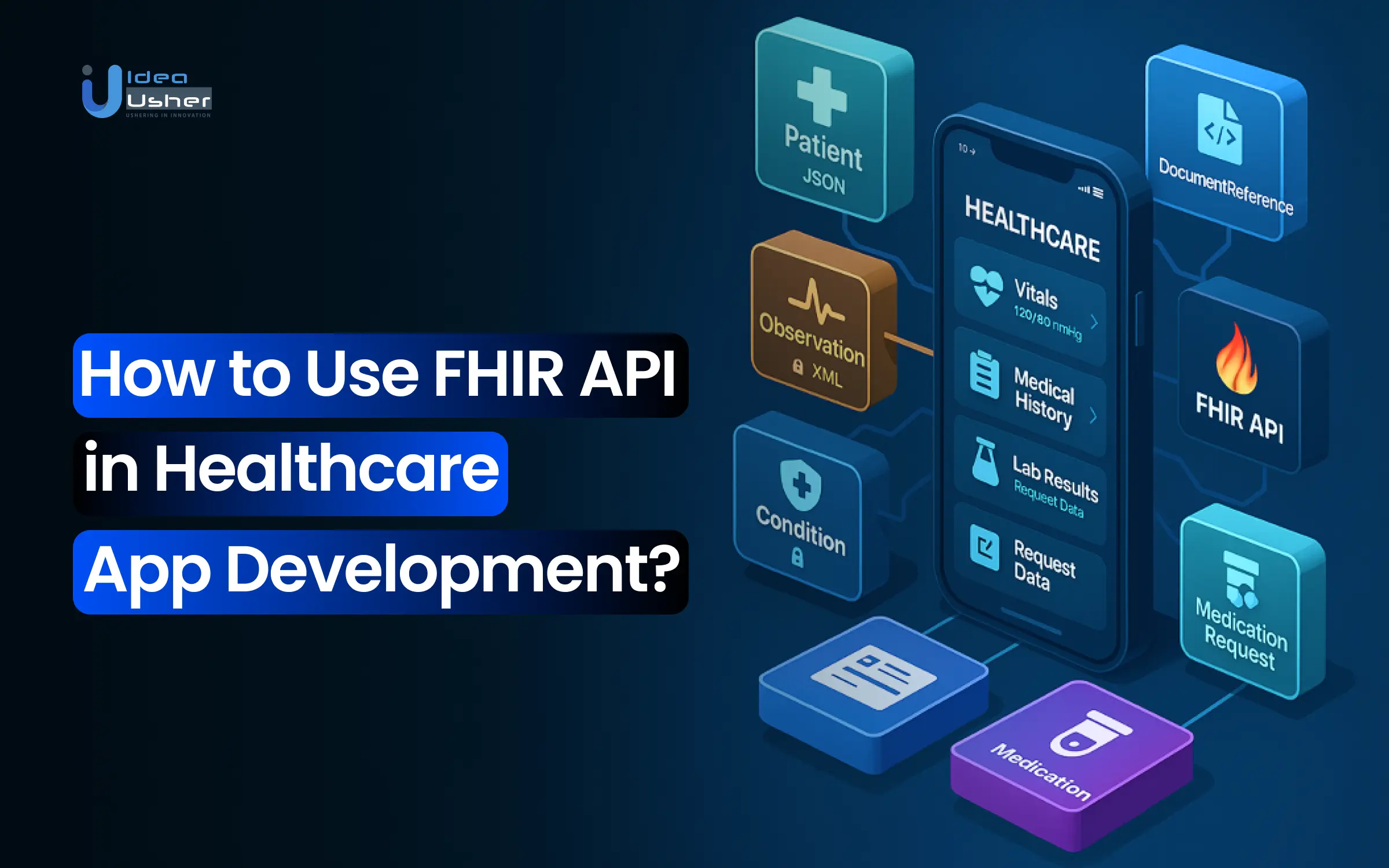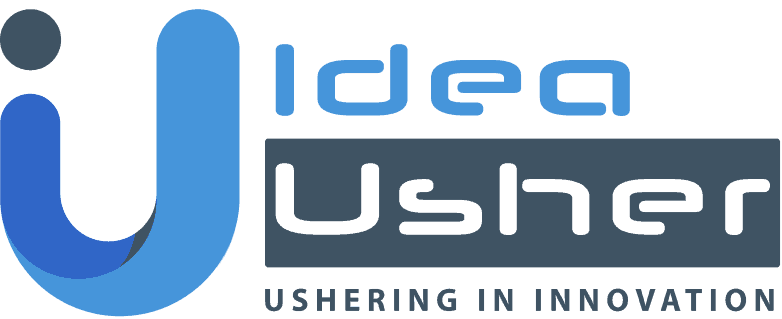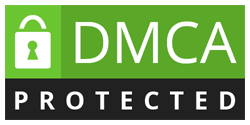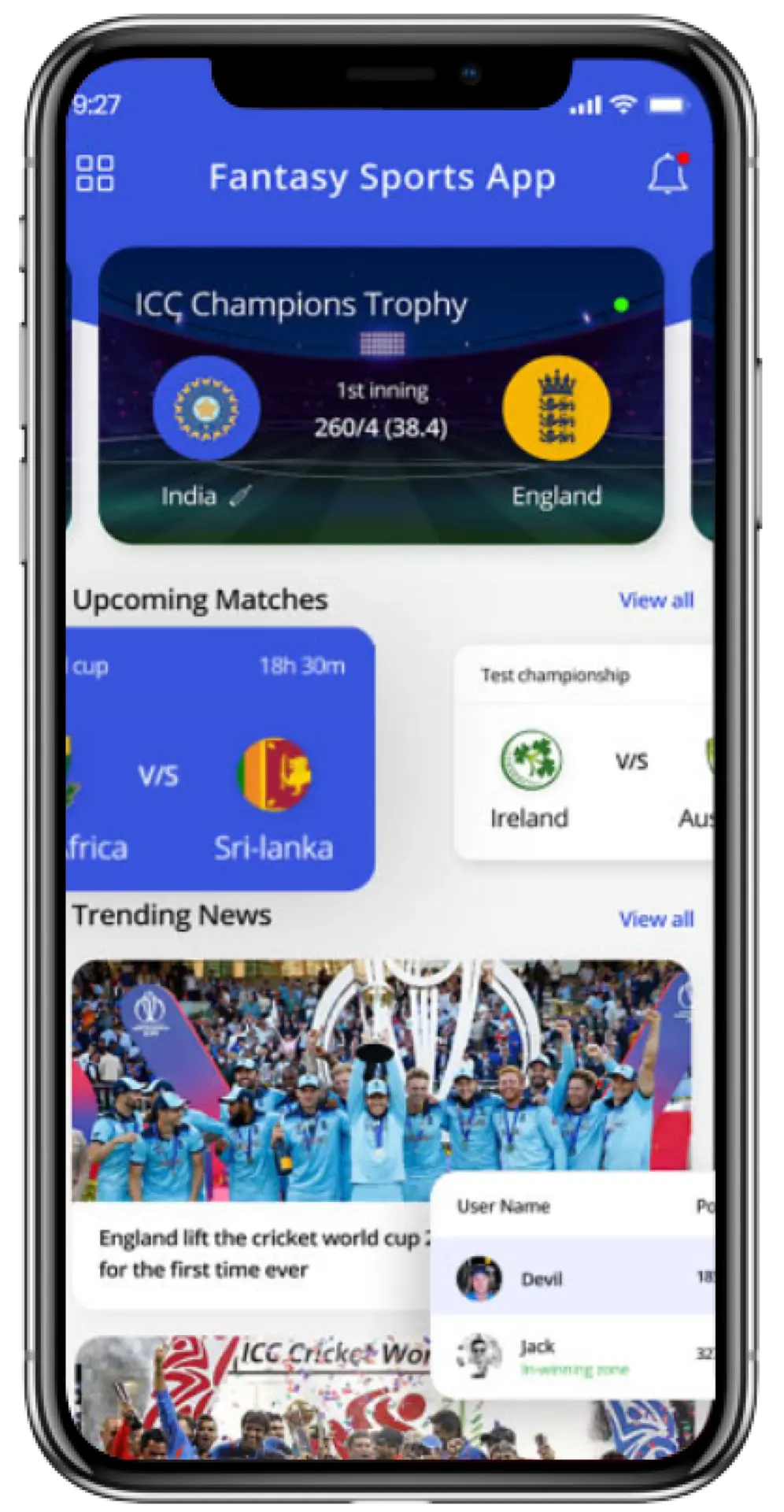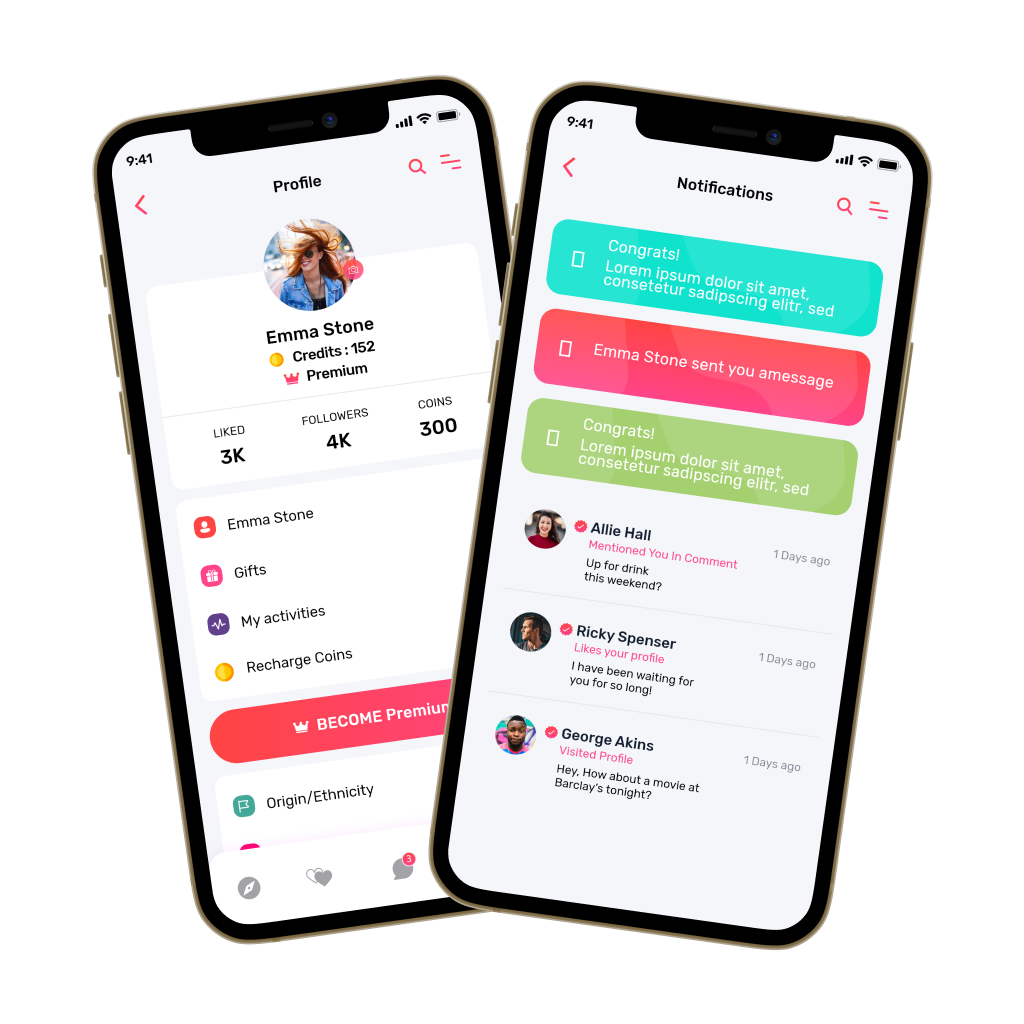The healthcare industry is embracing new technologies to enhance patient care and improve data interoperability. A key framework in this transformation is FHIR (Fast Healthcare Interoperability Resources), an API standard that facilitates easy exchange of healthcare data across systems. FHIR enables developers to create applications that ensure real-time access to critical patient information while maintaining security and regulatory compliance.
In this blog, we will talk about how to use the FHIR API in healthcare app development. We will explore its key benefits, implementation steps, and best practices for integrating it into your app, as we have developed many healthcare apps for numerous companies, and IdeaUsher has the expertise to integrate the FHIR API in your healthcare app, ensuring smooth and secure data exchange.

Why You Should Invest in FHIR API Integrated Healthcare Apps?
The global FHIR API Management market is experiencing significant momentum. According to our latest research, the market size in 2024 stands at USD 1.12 billion, and it is expected to grow at a CAGR of 19.8% from 2025 to 2033, reaching USD 5.36 billion by 2033. This growth is fueled by the increasing demand for interoperability and the adoption of FHIR (Fast Healthcare Interoperability Resources) standards in healthcare IT systems.
Health Gorilla, a platform offering healthcare data exchange solutions, raised $50 million in Series C funding to enhance its FHIR-based data-sharing platform. This investment showcases growing interest in platforms leveraging FHIR APIs to enable seamless healthcare data integration.
Tebra, a company focused on improving practice management for healthcare providers, raised $72 million in Series B funding. Its adoption of FHIR APIs allows healthcare providers to integrate data efficiently, improving patient care and operational workflows.
DrChrono, a leading EHR platform, secured $20 million in funding to enhance its FHIR-based healthcare solutions. This funding enables DrChrono to provide a scalable, interoperable system for practices and clinics, demonstrating the demand for FHIR-integrated solutions in healthcare.
The FHIR API Management market is on the rise, with companies like Health Gorilla, Tebra, DrChrono, and K Health leading the way in developing solutions that streamline healthcare data sharing and improve patient outcomes. Investing in healthcare apps integrated with FHIR APIs gives stakeholders an opportunity to be part of a fast-growing sector that is transforming healthcare delivery, offering significant growth potential.
What is FHIR API?
The FHIR API (Fast Healthcare Interoperability Resources API) is a set of application programming interfaces (APIs) designed to enable secure, standardized communication between healthcare systems using the FHIR standard. These APIs allow healthcare systems, applications, and services to exchange data in a structured and interoperable way, making it easier for healthcare providers to access, update, and share patient data across different platforms.
How FHIR API Differs from Legacy Standards (HL7 v2, CDA)?
FHIR API offers modern, flexible data exchange capabilities compared to legacy standards like HL7 v2 and CDA. Its focus on interoperability, ease of use, and web-based integration makes it more efficient and scalable.
| Aspect | FHIR API | HL7 v2 | CDA |
| Data Format and Structure | JSON/XML-based, resource-oriented format. | Delimited text-based messages with segments. | XML-based, document-centric format. |
| Interoperability | Highly interoperable with RESTful APIs, ideal for real-time data exchange and modern integration. | Limited due to message-based approach, and inconsistent implementation across systems. | Better than HL7 v2 but still document-oriented, harder to work with in real-time environments. |
| Ease of Use | Developer-friendly with RESTful APIs, widely used modern technologies (JSON, XML) make it easier to implement. | Complex with a steep learning curve due to varied message formats and lack of modern web support. | Better than HL7 v2 for structured data but still difficult for web-based applications to handle. |
| Real-Time vs Static Data | Designed for real-time data exchange with support for CRUD operations via RESTful APIs. | Primarily batch-oriented with delays in real-time data exchange. | Best suited for static clinical documents and reports. |
| Flexibility and Extensibility | Highly flexible with modular resources, supports custom extensions for diverse use cases. | Highly customizable, but lacks consistency across implementations, limiting extensibility. | Structured but static; less adaptable for dynamic, real-time data exchange. |
| Security & Authentication | Built for secure data exchange with OAuth 2.0 for real-time user authentication and data privacy. | Primarily focused on message integrity and security at the message level. | Relies on XML security, but limited by document-centric nature. |
What is SMART on FHIR?
SMART on FHIR is an extension of the FHIR standard that provides a framework for creating secure, interoperable healthcare applications that can work across various health systems. SMART stands for Substitutable Medical Applications, Reusable Technologies.
Key Features of SMART on FHIR:
- App Framework: SMART on FHIR provides an app platform, enabling the development of healthcare apps that can securely connect to EHRs and other healthcare systems.
- Security and Authentication: SMART on FHIR uses OAuth 2.0 for secure authentication, ensuring that only authorized users can access patient data. This makes it easy for third-party apps to integrate with healthcare systems without compromising privacy or security.
- Extensibility: SMART on FHIR allows developers to create custom applications that can be integrated with existing EHR systems or other healthcare services. This extensibility opens the door for innovations in healthcare, such as personalized care or new diagnostic tools.
- Interoperability: Since it is based on FHIR, SMART on FHIR ensures that apps can work across different healthcare systems, facilitating data sharing and improving care coordination.
Epic EHR and FHIR API Integration
Epic Systems has made significant progress in integrating FHIR API into its EHR system. Through its App Orchard program, developers can integrate third-party applications, enabling healthcare providers to access and share patient data more effectively while complying with regulations like HIPAA.
A. Overview of Epic’s FHIR-Based App Orchard Program
Epic’s App Orchard is a developer program offering resources for creating third-party apps that integrate with Epic’s EHR system. It utilizes FHIR-based APIs, allowing developers to access clinical data like patient records, appointments, medications, and lab results through standardized RESTful APIs.
- FHIR-Based API Integration: The App Orchard platform provides developers access to Epic’s FHIR-based APIs, allowing seamless integration with Epic’s EHR system.
- Sandbox Testing Environment: Developers can test their integrations using Epic’s sandbox environment, which simulates real-world conditions in a secure setting.
- Compliance and Certification: Epic’s App Orchard ensures that third-party applications comply with the standards set forth by Epic and healthcare regulations, offering tools for security testing and data privacy.
B. Plug-and-Play Possibilities for App Developers
One of the key benefits of the FHIR-based App Orchard program is its plug-and-play integration model, which simplifies the process for developers to connect their apps with Epic’s EHR system.
- Simplified Integration: FHIR APIs enable developers to integrate applications easily into Epic’s infrastructure, allowing for quick and seamless connections without the need for complex, custom interfaces.
- Flexibility for Various Applications: The FHIR-based App Orchard enables developers to quickly integrate apps for patient engagement, clinical decision support, and telehealth into Epic’s EHR system, streamlining the integration process.
- Enhanced App Discovery: Once integrated, third-party apps can be discovered through Epic’s App Marketplace, allowing healthcare providers to easily access and deploy the solutions that work best for them.
Benefits of Using FHIR in Healthcare App Development
Integrating FHIR (Fast Healthcare Interoperability Resources) in healthcare app development offers key technical and business benefits. It streamlines data exchange, boosts patient engagement, enhances compliance, and speeds up development processes. Here’s a look at the advantages of using FHIR in healthcare app development.
A. Business Advantages
Leveraging FHIR brings faster market access, improved patient engagement, and smoother regulatory compliance, which translates into long-term business growth.
1. Faster Market Access with Pre-Built FHIR APIs
FHIR APIs, like those from Epic’s App Orchard, offer pre-built endpoints for accessing patient data such as demographics, appointments, and lab results. For instance, a telemedicine app can utilize these APIs to accelerate development and enable quicker adoption by healthcare providers using Epic EHR systems.
2. Improved Patient Engagement and Care Coordination
FHIR enhances patient engagement through real-time data exchange, allowing instant access to health data via apps and portals. This integration enables healthcare providers to access the latest information, improving decision-making, reducing errors, and fostering collaboration for better patient satisfaction and care quality.
3. Meeting Compliance Requirements with Less Friction
FHIR supports OAuth 2.0 for secure authentication and data encryption, aiding compliance with HIPAA and GDPR. By using FHIR standards, apps can quickly meet security requirements, enabling developers to focus on innovation while protecting sensitive healthcare data.
B. Technical Benefits
Using FHIR in healthcare app development significantly streamlines data exchange and enhances both technical efficiency and scalability.
1. Interoperability Across Multiple EHR Systems
FHIR offers a standardized framework for data exchange between healthcare systems like Epic EHR and other EMRs. Integrating a mobile health app with FHIR enhances data sharing, improving care coordination and interoperability among providers.
2. Scalability via RESTful Architecture
FHIR’s RESTful architecture enables healthcare apps to scale effectively with growing data volumes. For instance, using FHIR-based APIs in a telemedicine platform maintains performance and responsiveness as user interactions increase.
3. Easy Mapping of Patient Records
FHIR’s standardized data models streamline the mapping of patient data like records, medications, and lab results. Integrating these FHIR resources into EHR systems like Epic ensures real-time access to patient information, improving clinical decision-making and minimizing data errors.

Step-by-Step Development Process FHIR API Integrated Healthcare App
Integrating the FHIR API into your healthcare app allows you to access and exchange clinical data in a standardized and secure manner. Below is a step-by-step guide to successfully integrate FHIR API into your healthcare application, covering everything from defining your use case to ensuring compliance and security.
1. Consultation
Before starting the integration, we consult with healthcare providers, EHR vendors, and development teams to define the specific use cases our app will address. For example, patient health record access, appointment sync, and lab result sharing. By understanding the required clinical data, we ensure that our FHIR API integration is tailored to meet the unique needs of healthcare systems.
2. Choose Your FHIR Version and Server
We select the most suitable FHIR version based on the healthcare system’s needs. R4, being the latest stable version, is widely adopted for clinical workflows and modern standards. Depending on the project scale, we decide between open-source servers like HAPI FHIR and commercial servers like Redox for robust enterprise-level integrations. The right choice enhances our FHIR API implementation.
3. Implement Authentication & Authorization
To ensure secure data access, we integrate OAuth2 into the app for authentication. After setting up OAuth2, we register our app with the EHR provider through their developer portal, ensuring secure access via the FHIR API. This setup allows both patients and providers to access sensitive data securely while adhering to industry standards for data protection.
4. Connect and Test FHIR Endpoints
Our team uses Postman or other REST API clients to test the connection between the app and the FHIR API. We fetch key resources such as Patient, Practitioner, Observation, and Medication from the EHR system. Ensuring proper formatting (JSON/XML) and validating that FHIR endpoints return accurate data is essential to maintaining app functionality.
5. Map and Normalize Data to Your App Structure
We handle clinical coding systems such as LOINC, SNOMED, and ICD-10 to ensure proper mapping of healthcare data in our app. By normalizing the data from the FHIR API, we ensure that it matches our app’s structure, guaranteeing consistency and usability. This process is vital for smooth integration and maintaining accurate, usable patient information.
6. Ensure Compliance and Security
We design the app with HIPAA and GDPR compliance in mind, ensuring encryption, secure data transmission, and restricted access to sensitive information. We also implement audit logging to track all access to patient data, along with a consent management system to ensure that users have explicitly agreed to share their data for specific purposes, ensuring security and compliance.
Common Challenges & How to Overcome Them
Integrating healthcare apps with FHIR-based EHR systems such as Epic or Cerner comes with its own set of challenges. These challenges range from vendor limitations to data mapping issues. Below are some of the most common obstacles developers face and how they can be overcome.
1. EHR Vendor Limitations
Challenge: Different EHR vendors use proprietary systems that may not fully support the latest FHIR standards or offer limited API access. This causes interoperability barriers between healthcare systems and slows down data exchange across platforms.
Solution: We will collaborate with vendors to access available API endpoints or advocate for future API updates. Additionally, middleware solutions like Redox or Human API will abstract complexity, enabling smoother data exchange and interoperability.
2. Data Inconsistency and Mapping Issues
Challenge: Healthcare data often comes in different formats like ICD-10, SNOMED, or LOINC, leading to inconsistencies when integrating with FHIR APIs. This makes it challenging to map and normalize data, causing potential issues in data accuracy.
Solution: We will use ETL (Extract, Transform, Load) processes to standardize data into FHIR-compatible formats. Collaborating with clinical experts and implementing automated data validation tools ensures accurate mapping and eliminates data discrepancies across systems.
3. Authorization Complexity
Challenge: Implementing OAuth 2.0 authentication for secure access in healthcare apps is complex due to varying user roles and strict security requirements, such as compliance with HIPAA.
Solution: We will implement SMART on FHIR for OAuth 2.0 authentication, leveraging role-based access control (RBAC) to ensure only authorized users have access to sensitive data, while designing a seamless and user-friendly authorization flow for minimal user friction.
4. Performance and Latency Issues
Challenge: FHIR API requests often involve large datasets, leading to potential performance bottlenecks or latency when querying complex resources like patient histories, lab results, and medication lists.
Solution: We will optimize API calls using pagination or batch requests to manage data efficiently. By implementing caching mechanisms and using asynchronous data processing, we ensure smooth app performance even with high traffic, hosted on scalable cloud platforms like AWS.
5. Lack of Internal FHIR Expertise
Challenge: Many development teams lack specialized knowledge in FHIR integration, making the implementation slow and leading to improper handling of healthcare data.
Solution: We will hire or train FHIR experts and partner with FHIR integration consultants for additional expertise. Additionally, we’ll engage in FHIR community forums and conferences to stay updated on best practices and ensure proper implementation of healthcare interoperability standards.
Tools, APIs, and Frameworks You’ll Need
When developing healthcare applications that integrate with FHIR, using the right tools, APIs, and frameworks is essential to ensure a smooth, secure, and scalable solution. Below is a breakdown of the key tools and resources you’ll need for FHIR server management, testing, development, security, and analytics.
A. FHIR Servers
FHIR servers are essential for hosting and managing healthcare data in a FHIR-compliant environment. Choosing the right server ensures efficient data access, scalability, and integration with EHR systems.
1. HAPI FHIR
HAPI FHIR is an open-source, Java-based server that simplifies the creation and management of FHIR-based applications. It provides a comprehensive framework for interacting with FHIR resources, making it easy for developers to set up a FHIR-compliant server and test applications.
2. Microsoft Azure API for FHIR
Microsoft Azure API for FHIR provides a fully managed, cloud-based solution to store and manage FHIR healthcare data. It offers a secure, scalable infrastructure for healthcare data exchange, with built-in features for compliance, data privacy, and interoperability across healthcare systems.
3. Google Cloud Healthcare API
Google Cloud Healthcare API supports the FHIR, HL7, and DICOM standards, enabling seamless integration with cloud-based healthcare applications. This service allows organizations to store and analyze healthcare data efficiently, ensuring interoperability and compliance with industry regulations on the Google Cloud Platform.
B. Testing Tools
To ensure your app’s integration with FHIR is accurate, robust testing tools are crucial. These tools help verify data exchange and API interactions seamlessly.
1. Postman with FHIR Collections
Postman is a versatile tool that allows developers to test FHIR APIs using pre-built collections. It simulates requests and responses, enabling developers to verify FHIR resource retrieval, validate data formats, and troubleshoot integration issues with minimal setup, ensuring smooth implementation.
2. Inferno (ONC Test Suite)
Inferno is an open-source tool developed by the Office of the National Coordinator for testing FHIR implementations. It provides a set of standardized tests to ensure compliance with regulatory and interoperability requirements, helping developers verify that their app aligns with FHIR standards.
3. Touchstone
Touchstone is an open-source testing platform that allows developers to validate their FHIR implementation by comparing it against real-world use cases. It ensures conformance to standards and helps identify interoperability issues, improving the quality and reliability of FHIR-based healthcare applications.
C. Development Libraries
Development libraries simplify the process of integrating FHIR into applications. These resources offer pre-built solutions for handling FHIR resources efficiently in different programming languages.
1. HAPI FHIR (Java)
HAPI FHIR (Java) is a Java library designed to help developers create FHIR-based apps easily. It provides tools for managing FHIR resources, making it easier to interact with and manipulate FHIR data in Java applications, saving time in the development process.
2. Firely .NET SDK
Firely .NET SDK enables developers to integrate FHIR functionality into .NET applications. It provides a simple interface for interacting with FHIR resources and supports both FHIR client and server-side implementations, streamlining the process of creating FHIR-compliant solutions within the Microsoft ecosystem.
3. SMART on FHIR JavaScript Client
SMART on FHIR JavaScript Client is a JavaScript library that facilitates integration of SMART on FHIR capabilities in web-based applications. It provides a simple interface for securely accessing patient data via FHIR APIs, supporting OAuth2 authentication and making real-time data exchange seamless.
D. Security
Security is a critical aspect of healthcare apps. Using trusted authentication tools ensures secure access to patient data, maintaining compliance with regulations like HIPAA and GDPR.
1. Auth0 or Okta (OAuth2)
Auth0 and Okta are cloud-based identity management solutions that enable OAuth 2.0 authentication in healthcare applications. These platforms provide secure user authentication and access control, ensuring compliance with HIPAA and other healthcare regulations while maintaining ease of use and scalability.
2. OpenID Connect Libraries
OpenID Connect Libraries extend OAuth 2.0 to enable secure, federated authentication for applications. By integrating OpenID Connect, developers can provide a single sign-on (SSO) experience while ensuring that access to FHIR resources is both secure and compliant with privacy regulations.
E. Analytics & Monitoring
Analytics and monitoring tools enable developers to track API performance and diagnose issues efficiently. These tools ensure real-time monitoring of FHIR-based transactions.
1. Datadog / New Relic for API Health
Datadog and New Relic offer comprehensive monitoring solutions for API health. These tools track response times, error rates, and the overall health of FHIR APIs, helping developers identify performance bottlenecks, monitor traffic, and ensure the app performs efficiently under varying load conditions.
2. Kibana for FHIR Logs
Kibana is a powerful visualization tool that works with Elasticsearch to monitor and analyze FHIR transaction logs. It allows developers to visualize and search through logs, enabling the detection of issues, errors, and performance discrepancies in the FHIR data exchange and API interactions.
Use Case: Building a Chronic Care Management Platform with FHIR
Problem Statement
A healthcare startup aims to create a remote patient monitoring (RPM) solution for chronic conditions like diabetes and heart disease, allowing healthcare providers to monitor patients in real-time, improving outcomes while reducing healthcare costs.
FHIR Integration Scope
The platform integrates with Epic EHR via SMART on FHIR to access patient vitals, medication adherence, and clinical notes. It provides real-time alerts and dashboards for healthcare teams, enabling timely decision-making and improving patient care coordination.
Results & Outcomes
By utilizing FHIR integration, the platform reduced hospital readmissions by 28%, enabled faster decision-making for clinicians, and scaled to 3,000+ patients across five states, enhancing chronic care management and improving patient outcomes.
Conclusion
Using the FHIR API in healthcare app development provides a powerful way to improve data interoperability and streamline the exchange of patient information. By adhering to this standard, developers can create applications that enable seamless communication between systems, ensuring that critical data is accessible in real time. FHIR’s ability to enhance efficiency while maintaining compliance with healthcare regulations is invaluable for both developers and healthcare providers. As the healthcare industry continues to evolve, FHIR’s role in facilitating secure and efficient data exchange will remain a cornerstone of modern healthcare app development.
Why Choose IdeaUsher for Your FHIR API Integration in Healthcare App Development?
At IdeaUsher, we specialize in integrating FHIR APIs into healthcare applications to streamline patient data management and improve interoperability. Our team has extensive experience in building FHIR-compliant healthcare solutions that empower healthcare providers to securely exchange and access critical patient information.
Why Work with Us?
- FHIR Expertise: We have a deep understanding of FHIR standards and the technology needed to integrate them seamlessly into your app, ensuring compliance and data security.
- Custom Healthcare Solutions: From idea to deployment, we offer tailored solutions that meet your specific healthcare needs, enhancing patient care and operational efficiency.
- Proven Success: We’ve helped healthcare companies such as Vezita, a telemedicine platform, integrate FHIR APIs for enhanced patient data access, CosTech Dental App, which streamlined its patient data exchange with FHIR, and Allied Health Platform, which utilized FHIR APIs for improved data sharing and collaboration among healthcare providers.
- Scalable & Secure: Our solutions are designed to grow with your needs while ensuring data security and compliance with industry standards
Explore our portfolio to see how we’ve helped healthcare businesses leverage FHIR APIs to create apps that enhance patient outcomes.
Get in touch today for a free consultation, and let us help you integrate FHIR API into your healthcare app to improve data sharing and patient care!
Work with Ex-MAANG developers to build next-gen apps schedule your consultation now
FAQs
FHIR (Fast Healthcare Interoperability Resources) is a standard for exchanging healthcare information electronically. It enables seamless data sharing across systems, improving interoperability and facilitating the development of efficient healthcare applications.
Start by selecting a FHIR server, such as HAPI FHIR, and integrate it using RESTful APIs. Ensure compliance with FHIR specifications and implement secure authentication methods like OAuth 2.0 for data access.
FHIR API enhances data interoperability, reduces development time, and supports scalability. It allows healthcare applications to access standardized data formats, improving the accuracy and efficiency of patient care.
Developers may encounter issues related to data mapping, versioning discrepancies, and ensuring compliance with healthcare regulations. Addressing these challenges requires thorough understanding of FHIR standards and careful planning during development.
